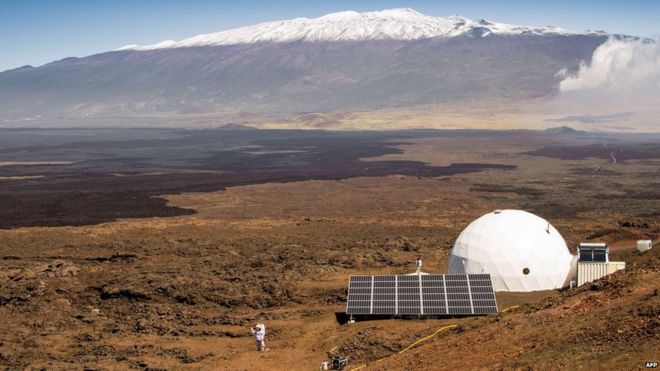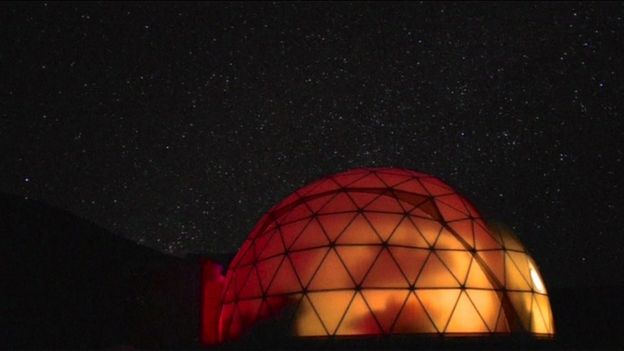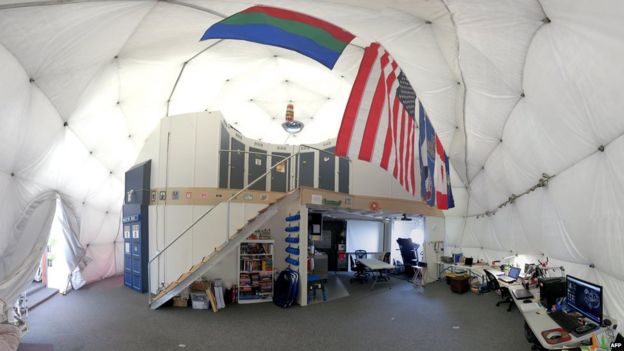
A team of six people have completed a Mars simulation in Hawaii, where they lived in near isolation for a year. Since 29 August 2015, the group lived in close quarters in a dome, without fresh air, fresh food or privacy. Experts estimate that a human mission to the Red Planet could take between one and three years.
The Nasa-funded study run by the University of Hawaii is the longest of its kind since a Russian mission that lasted 520 days. "The researchers are looking forward to getting in the ocean and eating fresh produce and other foods that weren't available in the dome", said Kim Binsted, principal investigator for the Hawaii Space Exploration Analog and Simulation.
The team consisted of a French astro-biologist, a German physicist and four Americans - a pilot, an architect, a journalist and a soil scientist.
The experiment dealt with the human element of exploration. While conducting research, the six had to live with limited resources, wear a space-suit when outside the dome, and work to avoid personal conflicts.

The location of the project was partly chosen for its remoteness

The team members had almost no privacy during the mission
They each had a small sleeping cot and a desk inside their rooms. Provisions included powdered cheese and canned tuna. Missions to the International Space Station normally only last six months.
Just how far are we from mounting a crewed mission to the Red Planet?
How far we can push humans, particularly in regard to extreme physiology, mental and emotional stress? Space analogue environment research aims to identify challenges and find solutions that will one day help to send a manned mission to Mars, and more importantly, see it safely return. The overall challenge of sending a manned mission to Mars is a jigsaw puzzle. Success is only possible using international collaboration to make use of all the pieces of research from space programs all over the world. This would incorporate the international lessons learned from astronauts onboard the International Space Station (ISS), the space shuttle and such analogues as the European Space Agency's Mars 500 mission and Concordia. This would also include physiological lessons learned in intensive care and medicine.
Some of the principal challenges include dealing with cosmic rays in space, surface radiation on Mars, storms of dust or "fines" (particles that are smaller than dust), the effects of weightlessness on humans and other physical challenges associated with long term space travel. Remaining healthy will be the greatest challenge for an astronaut travelling to Mars, both physically and mentally.
The space environment is harsh on the human body and astronauts must maintain good bone density, muscle mass and cardiovascular fitness in order to be able to effectively work in Martian gravity after an extending zero gravity transit.
The stepping stones that mark our progression towards a manned Mars mission may incorporate trips to asteroids, the Moon, points in deep space or even the moons of Mars itself.
Inspiring missions
There have been many failures of attempts to orbit spacecraft around Mars and land explorative space vehicles. Despite such losses, a US$2.5bn creation was born, built and launched in 2011. On August 6th this year, Nasa's Mars Science Laboratory (MSL) rover finally penetrated Mars' thin atmosphere and landed safely in Gale Crater.The mission's scientists hope that it will forge an exciting new chapter in Mars exploration; unlocking more secrets about the Red Planet's history.
Upcoming future planned projects to Mars, including the InSight and Mars Geyser Hopper missions are waiting in line, alongside projects from other countries such as India and China which have started to make their own plans.
We have never attempted a return trip; it has all been one-way exploration. Overcoming this challenge seems the next natural step and a crucial consideration for sending a manned mission.
Shared common projections predict a manned mission to Mars will happen, eventually.
All of this will take time and perhaps the earliest opportunity for humans to visit Mars would be the 2030s. Our knowledge and presence in space is playing a vital role in our future.
A manned Mission to Mars should be mankind's long-term goal and to achieve this will require long-term political and financial commitment and will only be successful as part of an international collaboration.
Armstrong's view
Earlier this year, in response to the budgetary and ambition cuts in Nasa, the late commander of Apollo 11, Neil Armstrong, expressed his sadness at the situation."Some question why Americans should return to the Moon. 'After all,' they say 'we have already been there.' I find that mystifying. It would be as if 16th century monarchs proclaimed that 'we need not go to the New World, we have already been there'."
No comments:
Post a Comment
Through this ever open gate
None come too early
None too late
Thanks for dropping in ... the PICs